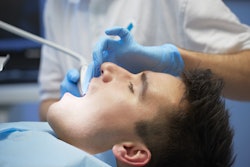I love a good fable. We all have a story of our Peter Perio. Peter Perio, a 42-year-old new patient, comes in for his examination, which includes radiography and a complete hard and soft-tissue assessment.
It has been half a decade since his last dental appointment. You note the glossy gingiva with a loss of stippling, rolled gingival margins, recession, and staining. There is plaque, calculus, periodontal pocketing, and bleeding.
 Dr. Dominique Fufidio.
Dr. Dominique Fufidio.
Peter Perio is diagnosed with generalized moderate (stage II) periodontitis, grade B perceived rate of progression, and the recommended treatment is scaling and root planing (SRP) in all four quadrants.
The diagnosis appears obvious, and the need for treatment is understood by Mr. Perio, so why then is dental benefit reimbursement for a straightforward claim seemingly more complicated? Do insurance companies really not want to pay for the treatment?
That is actually not the case. The truth is that the documentation must demonstrate visual bone loss that meets the insurance carrier's clinical policy to be deemed medically necessary and meet benefit criteria.
Medical necessity, proof of loss, clinical claims review … these are terms intertwined with the process of making benefit determinations and adjudicating a claim. While many factors are considered, the trend you will see toward the one declarer for SRP claims reimbursement -- above all else -- is evidence of visible bone loss. There is one problem though, visible can be perceived as a subjective word.
What I may interpret as bone loss, you may read differently. Knowing this, the insurance policy trend has moved toward the requirement of visible bone loss to mean radiographic bone loss of 2 mm or more, measured as the distance from the cementoenamel junction to the crest of bone.
I don’t know about you, but in dental school, I was taught that periodontitis is diagnosed when 4-mm probing depths are coupled with bone loss. But in retrospect, how much bone loss was never taught.
Astudy by Hausmann et al, published in the Journal of Periodontology asked the question, “What alveolar crest level on a BW radiograph represents bone loss?” Hausman et al concluded that a distance of 0.4 mm to 1.9 mm was consistent with no bone loss.1 Therefore, 2 mm or more was largely associated with pathology. Page et al quantified periodontal risk and disease severity and concluded that health was defined as less than 2 mm of radiographic bone height.2 Therefore, 2 mm or more was largely associated with pathology.
Without artificial intelligence to precisely measure these distances, the interpretation of the radiographic image again becomes subjective, but that is OK. Appealing an adverse determination is not the end of the world.
In fact, nearly 75% of claims are denied for administrative reasons. After appealing these claims, only about 8% are denied due to clinical insufficiency.3 That means you may just need to assist your claim in crossing the finish line.
To ensure the most successful claim submission for your SRP claims, ensure the following:
- Your bitewing radiographs actually capture the osseous crest. We can’t discuss bone levels if we can’t see the bone.
- Submit the x-rays that show the bone loss that you feel looks to be measuring at least 2 mm in distance from the CEJ to the crest of the bone.
- If you are appealing an adverse determination, submit an appeal narrative citing these specific areas so the claim reviewer can review the areas you feel have visible, radiographic bone loss in the detail you need.
- Send a panoramic radiograph as additional information and not as the sole radiograph for the claim. The detail required to evaluate bone levels or the amount of bone loss among 32 teeth is not achievable with a panoramic radiograph alone. Most dental providers will not diagnose periodontitis with a panoramic radiographic. However, if you acquired four posterior bitewings and have a panoramic image handy, the panoramic image will offer insight into the radiographic bone height of teeth # 7, 8, 9, 10, 23, 24, 25, 26 and, in many cases, the distal of # 1, 2, 15, 16, 17, 18, 31, and 32, when present.
- Make sure your submitted images are of diagnostic quality. If the images submitted for review are blurry, pixelated, scanned, photocopied, or of low contrast, the copies are not diagnostic and cannot be evaluated in the detail required to accurately adjudicate the claim.
Lastly, remember that the decision from the insurance carrier is a benefit determination, not a treatment recommendation. The treatment recommendation is clinically yours and yours alone. Please continue to treatment plan as you see fit, and remember that benefits are great when a patient can use them, but they are not designed to entirely offset the cost of treatment like major medical insurances.
Dr. Dominique Fufidio is the CEO, founder, and main coach at Fufidio Consulting Group, which provides dental benefits reimbursement coaching based on her experience as a former dental insurance claims reviewer and a private practice owner.
The comments and observations expressed herein do not necessarily reflect the opinions of DrBicuspid.com, nor should they be construed as an endorsement or admonishment of any particular idea, vendor, or organization.
References
- E. Hausmann, K. Allen,V. Clerehugh. What alveolar crest level on a bite-wing radiograph represents bone loss? J Periodontol. 1991; 62 (9):570-572.
- Page R, Martin J. Quantification of periodontal risk and disease severity and extent using the Oral Health Information Suite (OHIS). Perio. 2007; 4(3): 163-180.
- Miranda, Geraldo Elias, et al. Administrative and clinical denials by a large dental insurance provider. Braz Oral Res. 2015; 29(1):1-8.




















